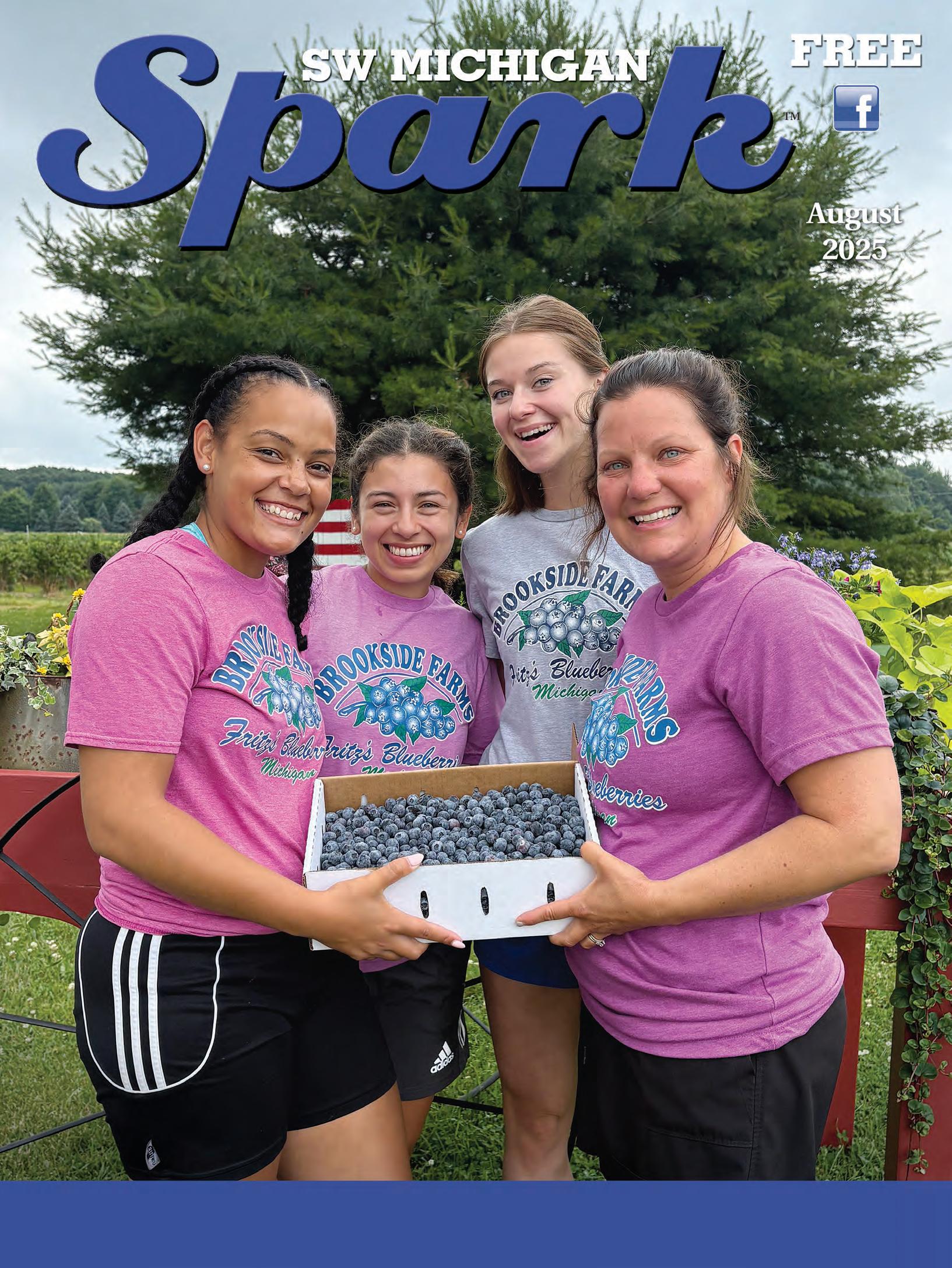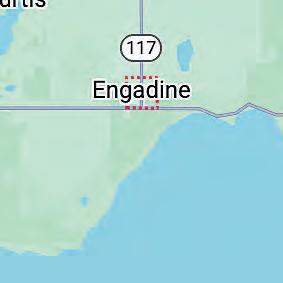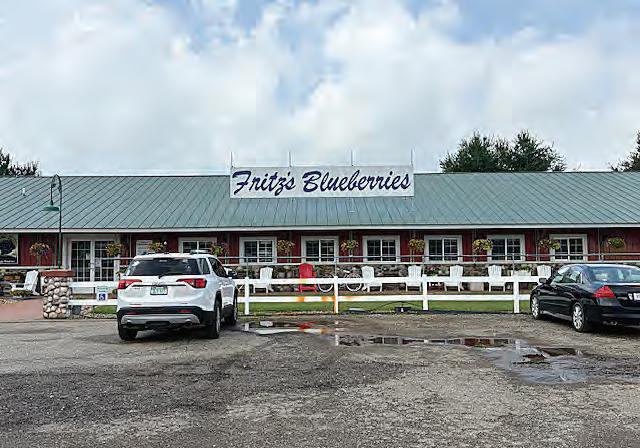
A BLUEBERRY A DAY KEEPS THE WORRIES AWAY! ~ PG. 10
Financial Services




A BLUEBERRY A DAY KEEPS THE WORRIES AWAY! ~ PG. 10


Q: Can you contribute to an IRA if you already participate with a company retirement plan?
A: Yes. You certainly can. For 2025, the maximum contribution to an IRA is $7000. If you are 50 years of age or older, you can add an additional $1000.
Something to consider is whether you will be able to deduct your IRA contributions during tax season. If you or your spouse have a company retirement plan, or your income is too high, you may not be able to deduct your IRA contributions.
The Atriums • 4341 S. Westnedge #1201 Kalamazoo, MI 269-323-7964

Q: What type of produce does Sawall’s carry?
A: Sawall’s has always carried local and certified organic produce. Its the very best quality that can be found. We receive produce orders almost every day! We also carry as much local produce that we can find seasonally. We are always looking for quality produce from local farmers. Come in soon and enjoy the areas largest selection of fresh CERTIFIED ORGANIC PRODUCE!!
Mon-Sat. 8am-9pm, Sun. 10am-6pm
Sawall Health Foods
Oakwood Plaza • 2965 Oakland Dr. at Whites Rd. • 343-3619 • www.sawallhf.com


Diana Duncan Director of Sales and Marketing
Q: When should I join a life plan senior community waiting list?
A: Waiting lists assure you preferred access to the specific floor plans you desire, as they becomes available. Timing depends on the list program structure. You rise faster through the list when the community limits “strikes,” or opportunities to reject a unit, before you drop back to the bottom. Progression through an “open ended” list is slow, but you may maintain your positon at the top indefinitely, until you are ready to move in. Most lists require a deposit and some provide access to community amenities while you wait. Proactive planning increases your options, so sooner is generally better than later.
“Where Connections Matter” 1400 North Drake, Kalamazoo 269-381-0560 www.friendshipvillagemi.com

Q: I prepaid for my funeral and I would like to move it to a different funeral home? Can I move it?
A: Yes! Your prepaid funeral is transferable. We can work with your current preneed arrangements and move them to one of our three locations. We will honor the same arrangements you have or, if you would like to make any changes, we will do that too.
You can get acquainted with our staff, ask any questions and we’ll create your funeral according to your wishes.
Compassionate care, meaningful memories
Adams - Redmond Funeral Homes and Cremation Services and Adams Funeral Homes and Cremation Services
3 locations to serve you
269.343.6156 Kalamazoo
269.349.7735 Parchment
269.657.6347 Paw Paw
www.adamsredmond.com www.adamspawpaw.com

Justin Reynolds Manager
Q: With all the recent stormy weather, should I have my roof repaired?
A: We recommend that roofs be inspected about once every five years if the roof is under 15 years old and then once every other year for roofs older than 15 years. These inspections can and should be done after the kind of stormy spring weather we have had this year. We have seen a little of everything since the first of the year including wind related damages and even hail damage on roofs that have been inspected so far this year. Inspecting a roof in this manner can often lead to minor repairs that can prolong the normal life expectancy of your existing shingles that are still in relatively good condition as this is confirmed more times than not during our inspections. For a free roof inspection, please give us a call at (269) 342-0153 or visit us at worryfreeroof.com


Q: What’s blood cancer and how do I know if I have it?
A: Blood cancer affects blood and the immune system. There are three main types: leukemia, lymphoma and multiple myeloma. While the exact cause is unknown, factors that increase your risk include age, family history, exposure to harmful chemicals and weakened immunity caused by conditions like HIV or immune-suppressing medications.
Symptoms may include extreme fatigue, bone pain, easy bruising, swollen lymph nodes or unexplained weight loss. If you notice these signs, talk with your primary care provider. They can do a physical exam and order blood tests or imaging to find out what’s going on.
The good news is that many people live full lives after undergoing treatment for blood cancer. If you receive a diagnosis, trust your care to the experts at Bronson Cancer Center. As the region’s leading healthcare system, Bronson offers advanced treatment options, access to research studies and support from a multidisciplinary team every step of the way.
While digging through a stack of Detroit sports programs the other day, I stumbled upon an old Red Wing program from 1969 with Sonny Elliot’s autograph on it. He was a popular Detroit weatherman back in the day, when the 6pm and 11pm TV newscasters were local celebrities
Sonny Elliott was known for making up words for various weather conditions. An example of this is when there was a wintery mixture of snow and sleet and it would become would becone “Sneet.”
He also loved to bring up the weather in the small town of Engadine, in the Upper Peninsula, pronouncing it, Enga-dinga-dine. Most viewers assumed this was where he grew up. I went through Engadine a few years ago, and stopped at a small grocery store, asking where Sonny Elliott once lived. The lady said that he was not from there, and she was not sure if he had ever even been there. However, they finally hung a picture of Elliot on the wall because so many people stopped and inquired about him.

Another popular Detroit personality, Erne Harwell, would also make reference to a town, when
broadcasting games at Tiger Stadium. When a foul ball would end up in the stands, he would often proclaim, “A young man from Imlay City will be taking home a souvenir tonight.” I was puzzled over this for years, wondering how he could possibly know that quickly where a fan was from? I came up with a few theories, including a very quick usher using a walkie talkie to wire the information to Ernie. Somebody finally told me that he
just made it up. He just enjoyed saying names of interesting small towns in Michigan.
I frequently travel around the state, and am often tempted to get off the highway to track down a small town I have heard about. This only works when I’m traveling alone, because most passengers have zero interest in taking these detours.


There are not many towns of interest to me that I haven’t visited along I-94, 131 or US-12, but the far reaches of the Upper Peninsula are fertile grounds to take back roads in search of interesting sounding towns.
Who can pass up, driving through the small towns named Slapneck, Diorite, Wobic, Betsy, Zeba, Swanee, Nisula or Mass City?
In stopping once for a beer in Mass City with friends, the bartender told us that the town was once simply known as Mass, but the post office kept getting so many letters addressed to Massachusetts, that they added City to the name.
The next time you have an errand to run, leave a little early and swing through Sherwood, Assyria, Pulaski or Alaska.
They are all close by.




Lee A. Dean screendoor @sbcglobal.net
For anyone curious to find out what kind of person they are, social scientists and social media are more than willing to help. Facebook quizzes have little value, but the social scientists have come up with multiple assessments commonly used in educational and business settings.
My favorite is the DiSC test, which at its most basic level divides human personality into four classifications. D is for “dominant,” I is for “influencer,” S is for “steady,” and C is for “conscientiousness.”
A D is decisive and gets things done. Famous Ds include Margaret Thatcher and George Patton. An I is an inspirational person. Many comedians are of this type, including Steve Martin and Robin Williams. The S is stable and prefers a supportive role, such as Mother Teresa while the C is compliant and careful, such as Bill Gates or Albert Einstein.
The combination of different types can help make a successful partnership. For instance, my wife, the Viking Goddess, is a relatively high D (she’s a goddess, after all) while I am a somewhat high S. If you want something organized, the
VG is hour girl. When we moved back to Michigan, friends who helped us were amazed that everything was packed in boxes, labeled, and with no mystery about the content of each box.
When our friends wondered who masterminded this operation, I said, “Don’t look at me. I couldn’t organize a two-car parade.” This skill may be why her mother, The Original Viking Goddess, would have named her Dwight if she had been a boy – “Dwight” as in “Eisenhower.” Girls can be generals, too.
We have been able to recognize, and blend, each of our personality types into a smooth working partnership. This may not be the case if an extremely high D partners with an extremely high S. This combination could mean big trouble. Say that this imaginary couple got to work building a piece of furniture from a kit. The D says, “Directions? I don’t need directions. I’m going in ALONE.” The same trait is true of following GPS directions on a drive.
S: Didn’t it say that we should have turned left here?
D: Hush. I know what I’m doing. The biggest problem with an S is that he will never exercise sovereignty over the GPS. He will simply do whatever it says, even though it sends him to Cleveland
when the device was told to give directions to Cheboygan.
Imagine a quartet of high S drivers arriving at a four-way stop at the same time. An hour could pass before anyone takes the initiative to go first, and chances are that all four would decide to go at the same time, bringing an unfortunate end to a game of vehicular chicken.
A very high S and high D would find engaging in conversation quite challenging. The “dialogue” about a conflict at work would go something like this.
D: I decided I had just about enough of this shabby treatment. I could have eaten a steel ingot and spat out thumbtacks. I marched right into the boss’s office. Didn’t even knock. Just barged right in and told him the truth. I didn’t give a rip about the consequences, either. Was that the right thing to do?
S: Well, I…
D: I told him how things should be done around here and that he was the reason we weren’t reaching our potential. I sure surprised him. His eyes were wide open and his mouth was clamped shut. He opened it long enough to tell me I was fired. What should I do now?
S: I think….
After three more rounds of this, the S slinks outside to walk the dog.
Our D and S characters take very different approaches to the subject of sleep. A D will wake you up for any reason. They will grab someone by the arm, shake you, and ask, “Are you awake?” On the other hand, an S will always let a D sleep, even if the house is on fire. Then, after the firefighters arrive, the S will beg them to delay the rescue until after he’s done watching the game.
Knowing these personality types affects the way I read history and biographies. I most admire the great figures who were a very efficient mixture of D and S, such as generals George Washington and Ulysses Grant.
To really have some fun, visit https://harmonyinsights.com/celebrity-disc/ and find out the personality types of TV and literary characters. I was happy to learn that fellow Ss include Marge Simpson and Frodo Baggins.
Montgomery Scott of “Star Trek” is an I, but that’s hard to believe. I claim him as an S. Think of all the times Scotty made an impossible repair and proudly reported, “Steady as she goes,” to his captain.
Anybody care to guess which personality type James T. Kirk is? You don’t need to have the logic of Mr. Spock (a C) to figure that one out.

By Richard Martinovich
The family-owned diner was once a staple in the community. It offered home-cooking away from home, at a reasonable price. Mar-Jo’s Diner in Schoolcraft is a pleasant reminder that the smalltown diner from years past still exists. A friendly, relaxed, down-home eatery where you might bump into someone you know!
Any breakfast you desire is readily available. Service is quick, staff attentive! You name it, Mar-Jo’s has it on the menu; blueberry, pecan or chocolate chip pancakes, Cinnamon French Toast, 2 + 2 + 2 Combo – choice of two pancakes or French toast, two eggs, two bacon strips -- Steak Scrambler – ribeye seasoned & grilled, roasted red pepper, hash browns, eggs -- Chorizo Omelet; chorizo, street corn Pico de Gallo, chipotle sour cream!


A hearty plate of Mar-Jo’s biscuits and gravy for breakfast is always popular, or Steak and Eggs to start your day! Many come for the omelets, the Marjo’s Omelet a favorite; hash browns, sausage, Swiss cheese, topped with house-made sausage gravy! Breakfast is served all day, and Mar-Jo’s Diner is known for its generous portions. In fact, you might have to sit a spell after breakfast! If you come for lunch, you’ll be just as amazed with the choices: Philly Cheesesteak, Patty Melt, wraps, hot beef sandwich with mashed pota-

toes, fried cod basket, French dip. Customers claim Mar-Jo’s burgers are the best around!
Marjo’s Burger – two patties, two Swiss cheese slices, two strips of bacon!!
There is a Senior menu, and one for kids, and plenty of luscious desserts!
Mar-Jo’s Diner has partnered with Three Rivers Coffee Company, and now has their own coffee blend -- and coffee mugs! Three Rivers Coffee is a veteran-owned small batch coffee company. It would take a long time to sample every item on the Mar-Jo’s menu, but you would have many savory memories!
Mar-Jo’s Diner is well worth the short drive from Kalamazoo, or stopping in if headed north or south on US-131.
325 North Grand Street • Schoolcraft • Monday-Sunday 7am-3pm

By Laura Kurella
Hubby has a few hobbies that keep him busy, such as rock-hounding and gardening, but in recent years he’s started collecting old radios. This new-found love for old radios has, by extension, drawn him into playing old classics that his 90+ year-old radios broadcast through digital ports he’s gotten installed on them, so they can play the music they did back in their hey day. Piping the same music to the speakers outside, our garden has been getting the benefit of their groove and seem to be thriving particularly well this year, making us wonder if the tunes have anything to do with it.
I personally find listening classics while gardening makes the work more enjoyable, especially when you have Ella Fitzgerald and Louis Armstrong serenading you with (phonetically) “You say ‘ta-mateoh’ and I say, ‘toe-mot-oh…’” while you weed the tomato patch! Being a couple of oldies ourselves, Hubby and I select only heirloom and organic varieties to grow and we’ve discovered that they tend to yield up hardy crops the first year and then volunteers year after year. In fact, we’ve learned that if you

plant an heirloom organic cherry tomato once you’ll likely have cherry tomatoes every summer for the rest of your life!
Since Hubby loves salsa, but has an issue with too much acidity, he thought it might be a good idea to grow heirloom yellows. Offering less acidity, we were surprised to also learn that yellow tomatoes came before the red ones did. In fact, yellow tomatoes were the very first tomatoes ever cultivated. It was only through natural mutations and selective breeding that the tomato grew larger and redder to what it is today, which now stretches it into being technicolor!
Yellow tomatoes do deliver less acidity, so they don’t upset his tummy. Because of that, I use them in the exact same way I do reds, making sure to tuck packets of its sauce into the freezer so I can in-
fuse its goodness in dishes I make all winter long.
Yellow tomatoes are good volunteers, too. As is our dill, Italian broccoli rabe, Bok choy, fennel, calendula, and mullein, etc. In fact, if this trend keeps up there will come a year where there will be no need for us to plant anything at all! There is a special joy gained from growing your own food, and we’ve also noticed that our vegetation tends to offers more flavor when compared against store-bought produce. This makes us wonder if perhaps you get more nutrition in home-grown produce! Mom used to say, “Freshest is always bestest!” and she was right! If you don’t have a garden this year, or don’t have the room, try growing a tomato plant in a bucket or a large pot. Garden centers in most stores still have tomato plants hanging around for cheap this late in the year, and a crop yielded from a single plant will pay for itself and more. Plus, it provides you with an excuse to play a few of your favorite tomato-inspired oldies, as well! Here now is a flavorful way to store up (with or without canning) a fabulous technicolor tomato treat.
Laura Kurella is an award-winning home cook who loves to share recipes from her Michigan kitchen. She welcomes comments at laurakurella@yahoo.com.

Prep time: 30 minutes; Cook time:15 minutes; Maceration time: 2 hours; Total time: 2 hours, 45 minutes.
Yield: 3 (1/2-pint) jars
Serves well with savory roasted meats and vegetables and is a sub for cranberry sauce with turkey.
2 1/2 pounds yellow tomatoes
4 ounces maple syrup
4 ounces honey
2 whole organic lemons
2 ounces fresh ginger
Place a 2-quart pot filled with clean water over high heat. Slice off the stem ends of the tomatoes then place them in a heatproof pot or bowl. Once water comes to a boil, Pour the boiling water over the stemmed tomatoes, and let rest. When cool enough to handle, drain water away then slip the skins off the tomatoes and then squeeze tomatoes to remove and discard most of their seedy gel. Discard skins and seedy gel then, using a sharp knife or processor, coarsely chop the tomato pulp that remains.
Place chopped tomato into a sterile (non-metal) bowl, then add the syrup and honey. Cover and place in the refrigerator for at least two hours or overnight. When rest time has passed,
sterilize three half-pint jars, and hold warm until you are ready to fill them.
While the jars sterilize, scrub the lemons clean using a scrubber and soap and water, then rinse well with clean water. Cut then seed the lemons well. Discard seeds and both the stem bud ends of the lemon. Peel ginger then, using a knife, grater, or processor, finely chop/grate the peeled ginger along with the prepared lemon, using both the pulp and its remaining rind. (NOTE: The lemon peel provides a natural pectin that gives this preserve a nice gel.)
In a large pot, combine tomato mixture with the ginger and lemon then place over medium heat and bring to a boil. Cook, stirring, until preserves being to set*, about 5 minutes. Ladle hot mixture into hot, sterilized half-pint jars leaving 1/2-inch headspace. Place seal on clean rimmed jars then process in boiling water bath for 5 minutes.
*=To test preserves for being set, pour a spoonful of your preserve onto a refrigeratorchilled plate then place it in the fridge for 5 minutes. If it wrinkles when pushed on with a finger, it’s set.


By Tom Springer, Vice President for Development
At first glance, it’s hard to picture the Spotted Lanternfly as a nefarious villain that poses a dire threat to the farms and forests of Southwest Michigan. It looks more like a gaudy broach, the kind that kids buy Mom at department stores for Christmas. It’s a strikingly beautiful insect, with two sets of wings: one beige with black spots, and the other with black, white and crimson stripes. The trouble is,
since the non-native Spotted Lanternfly didn’t evolve here, it has no natural predators. This, and its free-ranging, sap-sucking ways, can cause serious damage to vineyards, orchards and some hardwood trees.
The Spotted Lanternfly first appeared on the east coast in 2014. It likely hitch-hiked here on a plane or ship
from its native Asia. Michigan confirmed its first sighting in 2023, and the winged insect has since spread to five Detroit-area counties. It’s only a matter of time, says the Kalamazoo Nature Center’s Ryan Koziatek, before it makes its way to Kalamazoo. Yet as bad as that sounds, he says it’s not as destructive as other invasive pests.
“The Spotted Lanternfly doesn’t directly cause tree mortality the way the Emerald Ash Borer does,” said Koziatek, the KNC’s stewardship director.
“The ash borer eats the soft nutrients inside the tree’s bark between the deadwood and vascular tissue. That eventually kills the tree.
“But the Spotted Lanternfly is a sapsucker. In its nymph stage, it taps into trees and excretes a sugary liquid called honeydew. As honeydew drips down the tree, it forms a black sooty mold stain on the ground. The soot (which looks as gross as it sounds) can spread and kill plants, but not trees.”
When the Spotted Lanternfly does reach Kalamazoo, it will seek out its favorite partner in botanical crime: the Ailanthus, or Tree of Heaven. Since the Ailanthus also comes from Asia, it’s a preferred Spotted Lanternfly food source. Ailanthus thrives in gritty urban back lots and can spread its seeds along water ways such as the Kalamazoo River. All in all, a tough tree to stop.
“Tree of Heaven spreads by rhizomes (horizontal roots),” Koziatek said. “When you cut down the tree, it triggers a response that makes the roots spread like a Medusa. You need to apply a systemic herbicide on the stump that will kill it to the roots.”
What’s crucial now, Koziatek said, is to stop the spread of Spotted Lanternfly before it gains a foothold. To do so, follow the Michigan DNR’s edict of “see it, squish it, report it.” https:// www.michigan.gov/invasives/idreport/insects/spotted-lanternfly Another way to slow its onslaught is to destroy its egg cases. Look for them on tree trunks, car tires, even outdoor grills.
The greyish white clusters are 1.5 inches long, ½ inch wide, and resemble old chewing gum. Using the edge of a plastic card, scrape them into a sandwich bag that contains alcohol or hand sanitizer with at least 60 percent alcohol.
If all else fails? Mount a bat house near your home. Researchers from Rutgers University report that bats have developed a newfound taste for Spotted Lanternfly.
Tom Springer is vice president for Development at the Kalamazoo Nature Center and the author “Looking for Hickories,” and “The Star in the Sycamore.”




Lately, whenever a new Wes Anderson movie is announced, most of us have gradually stopped asking “what’s it about?” in favor of asking “who is in it?” Such is the impact of his idiosyncratic approach to direction, set design, screenplay, and tendency to assemble an absolute murderers’ row of actors to bring his films to life. The Phoenician Scheme stars Benicio Del Toro as wealthy businessman Sza-Sza Korda, a man whose questionable dealings have been made him a constant target of assassination attempts. In a bid to secure his legacy, he decides to name his daughter, a nun named Liesl (relative newcomer Mia Threapleton), his successor. As such, he includes her in his latest endeavor, a complicated infrastructure project which necessitates the involvement of a cavalcade of investors including Tom Hanks and Brian Cranston (as a pair of brothers) Scarlett Johansson, Jeffrey Wright, and Benedict Cumberbatch. Also along for the ride are Bill Murray, Willem Dafoe, F. Murray Abraham, and Michael Cera who turns in a career-best performance as Bjorn, an obsequious tutor with a secret. The Phoenician Scheme is quintessential modern Wes Anderson, and you probably already know how you feel about that. – Submitted by Patrick J.

Director and co-writer Carson Lund’s 2024 debut feature Eephus subverts the well-worn narrative of rival sports teams meeting up for one “great last game”. Set in a small New England town in the mid-1990’s, the movie follows the final game between two amateur baseball teams before their long-standing field is demolished. The grounds are dilapidated, and the team
late 20s and early 60s, may be getting there, too. However, there’s no back-story leading up to the playoff to put the rivalry in any context. Players arrive one by one, and the innings begin without fanfare. Dialogue is contained to what’s said on the field, in the dugouts, and between the very few spectators in attendance (only one player’s family shows up). All the while, plays are made, daylight fades, and time runs out. There’s no moralizing, no big point to drive home, no obvious revelation. Everyone involved (audience included) has to see the game through. Eephus offers a fascinating counter to the grandstanding manipulations of many sports films, no one can really perceive what’s happening as it’s happening.
– Submitted by Patrick
J.

Since her breakout role in the 2007 film Atonement, the American-born Irish actor Saoirse Ronan has lit up the big screen with one stellar performance after another, earning accolades and awards along the way. In last year’s The Outrun, Ronan delivers a dazzling rendering of a young woman battling family demons while confronting her addiction to alcohol. After spiraling out of control, losing her boyfriend, and falling victim to an assault, Ronan leaves London for the Orkney Islands, the setting of her childhood and where her parents continue to live. Holed up in a tiny cabin on a remote island called Papa Westray, Ronan takes a job studying a rare bird species. The natural beauty the island presents is as strong an influence upon Rona’s recovery journey as are its harsh conditions. The film’s plot unfolds nonlinearly, jumping from past to present, brilliantly employing Ronan’s unflinching portrayal of a woman attempting to come to terms with life’s burdensome challenges, and its possibilities for growth and joy.
– Submitted by Ryan G.
Reviews submitted by Ryan Gage. These great titles and others are available at the Kalamazoo Public Library.

By Jim Coppinger, Milestone Senior Services Volunteer
Donna Hicks spent most of her life in Illinois and Wisconsin. In 2021, she moved to Kalamazoo to be closer to her newly married daughter—and one year later, welcomed a new grandson.
She couldn’t be happier.
Donna grew up in a large Catholic family in Chicago before moving just outside the city. Her career path included work in distribution, imports and exports, and warehouse management— fields she found both challenging and rewarding.
She and her husband had one daughter. But when their daughter was just six years old, Donna’s husband passed away. Overnight, she became a single mother, focused on building a life that balanced work, parenting, and purpose.
Realizing she needed a job with more predictable hours, Donna shifted direction and began working with children and adults with intellectual disabilities. She quickly discovered how fulfilling the work was. Over time, her role expanded to include individuals with physical challenges and those dealing with substance use issues. In her work with Racine County, Wisconsin, Donna helped clients access essential services such as housing and medical care.
At the same time—and while raising her daughter—she earned her teaching degree and became a substitute teacher, adding another dimension to her already rich career of service.
Now retired, Donna still keeps a full and active schedule.

After a knee replacement and fighting off some persistent arthritis, she committed to a regular fitness routine. Every morning, five days a week, she faithfully rides her stationary bike and does strength training. “Those two things are a must,” she says. “They keep me going.” She also picked up a new hobby—archery. While she doesn’t hunt or compete, she enjoys it as a meditative
and energizing activity.
One day, she came across a Milestone catalog of volunteer opportunities and decided to get involved. Today, she serves as a Senior Companion volunteer, making three weekly visits to two women. She loves the connection and purpose it brings.
“My life is where it should be right now in every aspect, and I couldn’t be happier,” Donna says.
Her goal is simple: to help others find joy and live their best life. For her, volunteering isn’t a task—it’s another form of exercise for the mind and soul.
At the end of the day, after playtime and reading with her grandson, and time with her daughter and sonin-law, she says, “I can relax with a reassuring feeling, knowing it was a great day.”
Donna encourages anyone with even a few hours a week to get involved and experience the rewards it has to offer.
Milestone Senior Services (previously known as Senior Services of Southwest Michigan) is an AmeriCorps Seniors grantee. AmeriCorps Seniors empowers people age 55 and older to serve their communities. RSVP helps people find a volunteer opportunity that fits their passion. There are currently opportunities in Kalamazoo County and a few in Calhoun County. Volunteers are needed with Meals on Wheels, Kalamazoo Loaves & Fishes, Telephone Reassurance for Seniors, Milestone Home Repair, and more. Regular, flexible schedules available. Contact RSVP at 269-382-0515 or apply to volunteer at www.milestoneseniorservices.org.

By Dave Person david.r.person@gmail.com
It would be fair to say the Fritz family has blueberries in their blood.
From the time George and Barb Fritz planted the first blueberry bushes on their Brookside Dairy Farm between Gobles and Bloomingdale in the 1950s, they and their descendants have been harvesting berries on ever-expanding acreage that now includes farms and stores on 44th Avenue just off M-40 north of Paw Paw and on M-222 north of Otsego.

The three locations of Brookside Farms total nearly 500 acres, with 400 acres on the original Fritz farm in Gobles, 25 at the Paw Paw location and 12 in Otsego, says Kristin Kubiszak, one of five grandchildren of George and Barb Fritz who run the enterprise along with their fathers, Bill and George Fritz Jr.
In addition, there are 15 great-grandchildren — with Kubiszak’s daughter Molly,13, the oldest — who bring youthful enthusiasm to the operation.
“They just love doing everything,” Kubiszak says.
The original farm has been in the family since 1876 and got the name Brookside from the creek that runs through it.
But it wasn’t until 1957 when George planted the first blueberry bushes that its current identity was established. Today, Brookside Farms features many popular varieties of blueberries, such as Bluecrop, Elliot and Jersey, for which Kubiszak credits

her grandmother Barb.
“Grandma planted our farm perfectly,” she says.
Ninety percent of the blueberries are picked by hand, Kubiszak says, and half of all the berries harvested are by u-pick customers who visit the three farms from late June or early July to late August when the berries are ripe. Cost of u-pick berries is $1.80 per pound.

Brookside Farms hires and houses 500 seasonal workers under the federal government’s H-2A program. Those workers pick 40 percent of the berries, which find their way to the Michigan Blueberry Growers Association’s Naturipe Farms cooperative in Grand Junction, which is responsible for their distribution to retail outlets.
The other 10 percent are machinedpicked and processed.

While u-pick customers tend to return each year for the old standby varieties, grocers gravitate toward new offerings, Kubiszak says. Therefore, Brookside Farms is continuously planting new bushes and offering new varieties.
“If you’re going to keep up in the blueberry world, you have to be replanting,” she says.
They also create new products, such as this year’s Brookside’s Big Blues.
“When we have really big berries, we’re going to do a pack,” Kubiszak says of the quarter-sized blueberries separated from smaller berries and packaged together.
In addition to blueberries, the Paw Paw location — which was added 16 years ago — grows u-pick raspberries beginning in late August and the Otsego location — part of the Brookside operation for about 10 years — has raspberries and apples in the fall.
The stores at those two locations offer many additional products, including baked goods such as pies, muffins, doughnuts, turnovers and cookies, as well as honey from bees that are brought in to pollinate the fruit each June.
Visitors who don’t want to pick their own can buy ready-picked berries in 2-, 5and 10-lb. containers.
Kubiszak manages the Paw Paw store and her cousin Carly Parsley manages the one near Otsego. They are assisted by about 30 local, seasonal workers.

While there is no store at the Gobles location, there is a roadside stand, open Thursdays and Fridays, to honor the memory of Grandma Barb, who started the U-pick business around 60 years ago.

All locations are open for u-pick 9 a.m. to 7 p.m. Monday through Saturday and closed Sundays.
The farmhouse on County Road 388 where George Sr. and Barb Fritz lived is now an Airbnb, the Brookside Inn, run by the family.
The elder Fritzes are both deceased.
Kubiszak’s brothers, Peter and Josh Fritz, and Parsley’s brother, Lance Fritz, head up the horticulture aspect of the farm. In addition, Josh runs the packing operation in Gobles.

Their fathers, Bill and George Jr., remain involved in the overall business, and many of the spouses from both generations also play an integral role.
Kubiszak says none of the five grandchildren was pressured into making a career of the family business. In fact, all were encouraged to leave the farm after high school for either college, trade school or the military, and all of them did.
And all of them came back to the farm.
Keeping the farm in the family has had a positive impact in its operation since the siblings and cousins work well together, each with their own responsibilities, Kubiszak says.
“It’s literally the best,” she says enthusiastically when asked what it is like working with so many family members. “We all live within a five-mile radius and we do life together; we do church together; all of our kids go to school together.
“We don’t know anything different. It’s just what we’ve always done.”


Southwest Michigan Land Conservancy (SWMLC) is a non-profit conservation organization that protects and restores natural habitats in nine Michigan counties. Our Stewardship Crew is out in the field nearly every day, working hard to remove invasive nonnative plants, regardless of the heat and humidity. Their hours are long and tiring but there are a few perks – like cool animal encounters! Check out some of their recent finds . . .
This handsome little critter is a type of crayfish called a paintedhand mudbug. The Stew Crew found it prowling the rocks in the lake shallows near the creek at SWMLC’s Pilgrim Haven Natural Area near South Haven. It was an unusual sight because this burly native crayfish usually spends its time hanging out in a wet, palatial, underground burrow that it digs for itself.

A very friendly fritillary couldn’t resist landing on ‘butterfly magnet’ Lukas Bolton while he was working at one of our refuge preserves on the Paw Paw River. Some folks just have that kind of charisma!


Collin Klute caught some quick snaps of this laidback gray rat snake loitering high in the branches of a tree (“just thought I’d drop by!”) at SWMLC’s Kesling Nature Preserve near Three Oaks. This was especially good because gray rat snakes are listed as Threatened

in Michigan, which says a lot about the high quality of the habitat at Kesling and other nearby protected lands.
At SWMLC, loving nature means protecting it from pollution and development, restoring habitats so a wider variety of wildlife and plants can thrive, working to keep water clean, and striving to make our region strong in the face of climate challenges. We’re a local nonprofit organization that depends on donor support to do all this important conservation work (and more) in Allegan, Barry, Berrien, Branch, Calhoun, Cass, Kalamazoo, St. Joseph, and Van Buren Counties.
If your love for nature and the environment has started to feel more like worry, put your concerns into action – whether that’s hands-on volunteering or donating your hard-earned cash to conservation groups like SWMLC. Working together, we can help heal nature and make sure it will still be healthy for generations of people (and wildlife) to come.
Learn more about us at our website, www.swmlc.org.

Shortly after the village of Bronson (Kalamazoo) was established in 1831, “a diagonal road from Gull Prairie to Bronson” was surveyed, most likely following a trail laid down long beforehand by native inhabitants. Although it was little more than a dusty dirt path, the road made travel possible between the villages of Kalamazoo and Richland (then known as Gull Corners) and nearby Gull Lake. Back then it was called the road to Gull Prairie or Gull Corners Road. Today, we know it simply as Gull Road.
by Keith Howard, Kalamazoo Public Library

By the 1840s, a popular stagecoach line followed the Gull Prairie Road from Kalamazoo to Gull Corners before continuing northward to Grand Rapids. But travel in those days was slow. The trip by stagecoach from Kalamazoo to Richland took several hours, and theon to Grand Rapids was an all-day endeavor.
During the 1850s, newlywed Vermont natives Gardner and Christina Hunt opened a tavern on their property along the east edge of the Gull Prairie Road in Comstock Township, about 4 miles northeast of Kalamazoo. The landmark tavern
stood roughly where 26th Street now meets Gull Road, a convenient stopping place midway between Kalamazoo and Richland where stagecoach drivers could change horses while their passengers enjoyed a bit of refreshment. According to local legend, the tavern “did a flourishing business and its fame spread far and wide among the traveling public.”
For several decades, the Hunt family served up home-cooked meals and provided overnight accommodation for road-weary travelers. According to the Kalamazoo Gazette, Hunt’s Tavern became

“widely known throughout the state because of its attractive surroundings, its homelike appearance and the kind and hospitable proprietors.”
Gardner Hunt passed away in 1879 at the age of 67.
Christina Hunt continued to operate the tavern on her own until 1891, after which it was leased to others for a variety of uses. In the winter months during the 1890s, folks from Kalamazoo often hosted oyster suppers at the tavern. Individuals would rent the dining room, bring their own barrel of oysters, hire an orchestra, and dance until the wee hours.
After Christina Hunt’s death in 1912, the building fell into disrepair and was eventually torn down. Today, Gull Road serves as a main artery between downtown Kalamazoo and the rapidly developing areas in northeast Kalamazoo County. Homes, apartments, restaurants, commercial structures, and parking lots now shape the landscape where Hunt’s Tavern stood so long ago.
More at kpl.gov






Let’s try a quick check-in: Right now, as you’re reading this, gently unclench your jaw and let your shoulders relax. Did you notice yourself holding tension you weren’t even aware of? You’re certainly not alone. Life brings its share of demands, chronic stress can often become an uninvited guest, sometimes quietly, sometimes loudly.
While a little stress can be a motivator, too much can chip away at our well-being. As Rebecca Lillie, Association Health and Wellness Director at the YMCA of Greater Kalamazoo, reminds us, the challenge isn’t eliminating stress entirely, but learning how to manage it. Unchecked stress can contribute to issues like anxiety, depression, and increase our risk for heart disease or stroke.
Understanding Stress: Your Body’s Ancient Alarm
Stress is essentially our body’s “fight or flight” response—a natural reaction to challenges or demands that disrupt our
sense of calm. In small doses, this can be helpful. However, the kind of chronic, low-level stress can be deeply detrimental, silently eroding our vitality. This can stem from life’s big moments – caring for loved ones, adapting to retirement, or even navigating changing family dynamics – or simply the daily grind.
Spotting the Signs: How Stress Shows Up
Recognizing how stress manifests in your life is the first step. For some, it might be a subtle shift in mood – perhaps a quicker temper or a lack of enthusiasm. Others might notice changes in sleep patterns, digestive issues, or relying more on comfort foods.
Cultivating Calm: Adaptable Strategies for Well-being
The good news? There are powerful strategies we can adopt to counter the effects of stress. Rebecca offers excellent, time-tested advice, adaptable to various abilities and circumstances:
• Move Your Body, Your Way! You don’t need to run a marathon. Even gentle movement makes a difference. The goal is to get your blood flowing and release tension.
• Nourish Yourself Thoughtfully. Prioritize fresh fruits and vegetables when you can. If fresh options are challenging, frozen or canned varieties are excellent, affordable alternatives. Be mindful of added sugars.

• Prioritize Restful Sleep. Aim for a consistent sleep schedule that allows you to feel rested.
• Practice Positive Self-Talk. Our inner dialogue profoundly affects our outlook. Look in the mirror and remind yourself of your strengths and wisdom.
• Embrace Gratitude. Make a conscious effort to notice and appreciate the good things, no matter how small. This intentional shift in focus can rewire your brain towards positivity.
• Nurture Your Connections. Social bonds are crucial for well-being. Call a friend, meet for lunch, or join a local community group or club that aligns with your interests.
• Share Your Experience. Talking openly about your worries with trusted friends or family can provide immediate relief. By intentionally weaving these practices into our daily lives, we can not only manage stress but also cultivate a deeper sense of peace and well-being, allowing us to truly thrive.
Important Note: While these strategies can significantly help, if stress feels overwhelming, persistent, or is significantly impacting your daily life, please don’t hesitate to reach out to your doctor or a mental health professional. Support is available.
Submitted by Vicky Kettner, Association Director of Marketing, Community Relations, and Member Engagement at YMCA of Greater Kalamazoo.







Poston’s newest title is a delightful romance story with some magical realism. Joni Lark is a wildly successful songwriter, but unfortunately, she has a terrible case of writer’s block. Her mother’s newly diagnosed dementia, the closing of the family music venue that started her love of music, and the uncharacteristic silence of her best friend have all blended to create stress she cannot outrun. When she goes home for the summer to see her mother, there is a melody she cannot get out of her head. And, along with it, the voice of a man who can also hear it. She is sure that this is all in her head until he shows up in the flesh. They assume that if they can write the song that is stuck in both of their minds, they can break the connection and stop hearing each other’s thoughts. But what if that tune is stuck in their heads for a reason?

There have probably been hundreds of books written about the Beatles from almost every possible angle. This new book by Ian Leslie, however, explores something different. He looks at the complex relationship between arguably two of the best songwriters of the 20th century, John Lennon and
Paul McCartney. He starts back when they meet as teens in Liverpool, and follows them as they dip into songwriting, encouraging each other, spurring each other on. He looks at how the competitiveness between the two pushed them to write better songs. Most of all, he shows the complicated and deep love these two men had for each other through the years, from aspiring rockers in Hamburg, Germany, to the dizzying heights of Beatlemania, and through the pain of the eventual breakup. The author examines their intense friendship through the songs they wrote, artfully explaining how their talents perfectly complemented each other.

Johnston debuts with a sweet story of mistaken identity and second chances. The narrative begins when as impoverished widower Fred Fife tries to help a nonresponsive man, who turns out to be nursing home resident Bernard Greer. A nursing home employee ushers Fred, who looks just like Bernard, back to the home. Because Bernard exhibited signs of dementia, nobody believes Fred’s insistence that he doesn’t belong there. This lovely novel will help you see beyond your worries in life, and even sometimes, the beauty of these experiences. The Borrowed Life of Frederick Fife leads you through the joys, struggles, and chaos of many characters through the eyes of a widowed, elderly, kind gentleman.
All these titles are available at the Portage District Library. For more information about programs and services available at PDL, go to www.portagelibrary.info





This past June, my son Sam and his wife Becca, were married in Asheville, North Carolina.
Asheville is located in the mountainous, northwest part of North Carolina, about halfway between Charlotte and Knoxville, Tennessee.
It was a fun wedding and gave Jackie and I an opportunity to spend time in this great area.
We knew that Hurricane Helene had devastated parts of Asheville and saw many parts of town that were damaged. Before Helene, Asheville had experienced several major floods including the catastrophic Flood of 1916, known as “The Flood by Which All Other Floods Are Measured,” but this one was worse. The river gauge in Asheville exceeded the 1916 record by over 1.5 feet, Our first stop in Asheville was the River Arts District (RAD) along the French Broad River.
Many gallery buildings had reopened since the flood, but others were destroyed and we could see the devastation everywhere. One large brewery had just reopened and an employee pointed to a mark on an interior wall, where the flood waters had reached 13 feet.
This old industrial part of Asheville, was the beginning of Asheville’s arts scene, restoring old dilapidated buildings into a vibrant hub of creativity.
In the late 2010s, a major project enhanced roads and sidewalks, creating better walkable connections within the RAD. Efforts to restore the French Broad River from industrial pollution have made it a hub for kayaking, paddle boarding, and floating.
We checked into the downtown Embassy Suites by Hilton Asheville, It is a modern hotel with a very large lobby and free breakfast. They have a cool indoor/outdoor Soprano Rooftop Cucina restaurant where we had a pizza one night.
The hotel was the perfect location for walking the few blocks to the main shopping and dining district downtown. We stumbled upon the Blackbird Restaurant for a late breakfast and enjoyed
By Steve Ellis

their lively flair at this eclectic spot on Biltmore Avenue.
Not far away was the historic Grove Arcade that was recommended as a must see.
It was built in 1929, by E.W. Grove. The 269,000 square-foot building, with its ornate architecture, and eclectic mix of shops and restaurants was designed to offer patrons a fullday immersion into Asheville lifestyle and culture and America’s first indoor shopping mall. Grove made a fortune in the patent medicine business with his Grove’s Tasteless Chill Tonic and Laxative Bromo Quinine tablets.
selling handmade jewelry, paintings, farm products and much more.
One morning ,we drove north out of town through Woodfin and Weaverville. Jackie asked at a gas station about a good local breakfast


Over the years, the Grove languished and had many uses. It was restored to its original splendor in 2002 and is now packed with local crafts & arts, restaurants and 42 luxury apartments.
We browsed several of the stores and enjoyed the outdoor Makers Market, with a dozen stalls filled by local artisans
spot and the clerk immediately said Granny’s Kitchen. We quickly found it and enjoyed a great Southern breakfast. The friendly folks sitting next to us said that Granny’s has been open for 30+ years and sadly, Granny passed away last year.
Back in Asheville, a friend attending the wedding told us of finding an old fashioned soda fountain, in a former Woolworth’s store, so we decided to check it out.
The block-long, F.W. Woolworth building was established in 1938 and restored in 2001. The building houses a soda fountain built to resemble the original Woolworth Luncheonette. It is open daily, serving many of the original menu items, including egg creams, club sand-
wiches, coffee and ice cream sodas. The majority of the building is packed with 170 local artists offering a vast array of jewelry and fine art.
Asheville’s most famous landmark and one of the highlights of our trip was visiting the 178,000 square-foot Biltmore Mansion and Gardens. The Biltmore will be featured in a future issue.
Sam and Becca’s wedding was held at the Highland Brewing Company. The brewery is the largest independent, family-owned brewery native to the Southeast.
In 1994, Oscar Wong, a Chinese-Jamaican immigrant opened Asheville’s first brewery using refurbished dairy equipment in the basement of Barley’s Taproom. This humble beginning laid the foundation for what would grow to over 35 Asheville breweries.
In 2006, Highland moved to a sprawling 11-acre facility on 40 acres of land in East Asheville. This former movie studio was transformed into a destination brewery featuring five sand volleyball courts, and an 18-hole disc golf course. On our last day in Asheville, we had an afternoon flight so decided to check out the Blue Ridge Parkway.
The Parkway is a National Parkway noted for its scenic beauty. It is the longest linear park in the U.S., and runs 469 miles through Virginia and North Carolina, linking Shenandoah National Park to the Great Smoky Mountains National Park.
The parkway has been the most visited unit of the National Park System almost every year since 1946 and there is no fee. There are numerous parking areas at trailheads for the various hiking trails and we found a couple nice ones..
Our last stop before boarding the plane home was at the Sierra Nevada Brewing Company. The brewery and grounds are massive and not like any brewery we have ever visited. The brewery, gardens and wooded hiking trails draw thousands of daily visitors, throughout the year. The cozy interior atmosphere features a popular tapas menu as well as more traditional fare.





